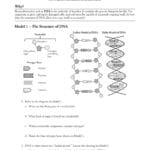Unlock the secrets of heredity with the power of Punnett squares! This comprehensive guide provides clear steps, engaging activities, and free downloadable worksheets to help you master the art of predicting genetic inheritance. Whether you’re a student, educator, or simply curious about genetics, this guide equips you with the knowledge and resources to navigate the fascinating world of Punnett squares, from basic Mendelian inheritance to complex genetic scenarios.
Decoding Inheritance: Understanding Punnett Squares
Punnett squares, developed by geneticist Reginald Punnett, are invaluable tools for visualizing how genes combine and predicting the probability of offspring inheriting specific traits. They’re like genetic crystal balls, offering insights into the likelihood of various characteristics being passed down from parents to their children. Think of inheriting traits like a lottery – you receive one “ticket” (allele) from each parent, and the combination of these tickets determines the outcome.
[https://www.lolaapp.com/nutria-vs-muskrat]
Exploring Different Types of Punnett Squares
Just as there are diverse inheritance patterns, there are various types of Punnett squares:
Basic Monohybrid Crosses: One Trait at a Time
These foundational Punnett squares focus on the inheritance of a single trait, governed by one gene. For example, predicting the probability of a child inheriting attached or detached earlobes. Monohybrid crosses illustrate the interplay between dominant and recessive alleles and provide a clear understanding of Mendel’s fundamental laws of inheritance.
Dihybrid Crosses: Two Traits Simultaneously
Dihybrid crosses take things a step further, examining the inheritance of two traits simultaneously, such as eye color and hair color. These squares reveal how different genes can be inherited independently or sometimes influence each other, leading to a broader range of potential outcomes.
Incomplete Dominance: A Blend of Traits
In incomplete dominance, neither allele is fully dominant, resulting in a blend of traits. Imagine a red flower and a white flower producing a pink offspring – that’s incomplete dominance at work! These Punnett squares showcase how this blending occurs at the genetic level.
Codominance: Both Alleles Shine
Unlike incomplete dominance, codominance allows both alleles to be fully expressed. Picture a flower with both red and white patches – that’s codominance in action. These squares exemplify how both traits can manifest simultaneously without mixing.
Multiple Alleles: More Than Two Options
Some traits have more than two possible alleles. Human blood type, with its A, B, and O alleles, is a classic example. These specialized Punnett squares help navigate the various combinations when multiple alleles are involved.
Sex-Linked Traits: X and Y Chromosomes
Certain traits, like color blindness or hemophilia, are linked to the sex chromosomes (X and Y). This unique linkage results in distinct inheritance patterns between males and females. These Punnett squares illuminate how these traits are passed down differently between the sexes.
[https://www.lolaapp.com/peacock-butterfly-inachis-io]
Pedigree Analysis: Tracing Traits Through Generations
Pedigree analysis, like a family tree for genes, tracks traits across generations, helping identify patterns of inheritance. This type is especially useful for understanding genetic disorders and predicting their likelihood in future generations.
Hands-on with Punnett Squares: A Step-by-Step Guide
- Identify the Alleles: Determine the different versions of the gene (alleles) each parent carries. For instance, ‘B’ for brown eyes and ‘b’ for blue eyes.
- Construct the Square: Draw a 2×2 grid, placing one parent’s alleles along the top and the other parent’s alleles along the side.
- Combine the Alleles: Fill in each square by combining the corresponding alleles from the top and side. This represents the potential genotype of an offspring.
- Calculate Probabilities: Analyze the filled squares. How many times does each genotype appear? This indicates the probability (likelihood) of an offspring inheriting that genotype.
- Interpret the Results: Translate the genotypes into phenotypes (observable traits). For example, if “BB” and “Bb” both result in brown eyes, calculate the overall probability of an offspring having brown eyes.
Where to Find Punnett Square Worksheets
Numerous online resources offer free printable Punnett square worksheets catering to different learning levels:
- University of Utah (Teach.Genetics): Interactive “Mutt Mixer” activity and related worksheets.
- Science Notes and Projects: Free genetics worksheets, projects, and quizzes.
- Leon County Schools: Vocabulary, examples, and problem-solving worksheets.
- Amazing World of Science with Mr. G: Worksheets on monohybrid crosses, dihybrid crosses, and sex-linked traits.
- Quizizz: Printable worksheets and interactive quizzes.
- Education.com: Worksheets and instructional resources.
- Twinkl: Teaching resources for Punnett Squares.
- Teach Starter: Downloadable and printable worksheets.
- Tes: Worksheet with answers focused on Punnett squares.
The Power and Limitations of Punnett Squares
Punnett squares offer a powerful glimpse into the probable outcomes of genetic crosses, but it’s crucial to remember they represent probabilities, not certainties. Like weather forecasts, they provide predictions based on available information, but the actual outcome can vary. Genetics is a complex field, and ongoing research continually refines our understanding of inheritance. Punnett squares provide a simplified model and don’t account for every possible genetic scenario, such as environmental influences or polygenic inheritance (traits influenced by multiple genes). They are invaluable tools for understanding basic inheritance principles, but they represent a starting point in the ongoing exploration of genetics.
- Unlock Water’s Symbolism: A Cross-Cultural Exploration - April 20, 2025
- Identify Black and White Snakes: Venomous or Harmless? - April 20, 2025
- Unlocking Potential: Origins High School’s NYC Story - April 20, 2025















